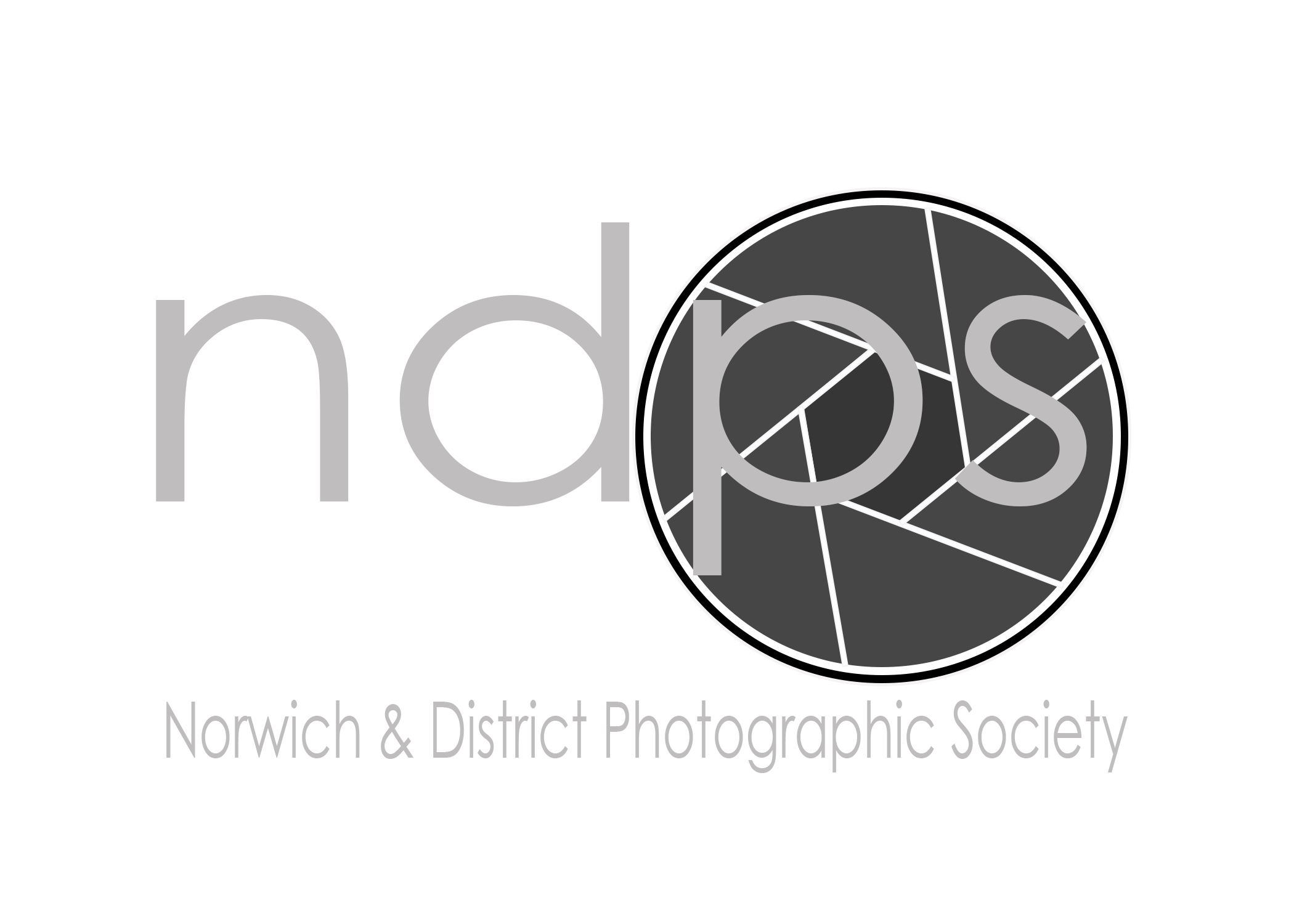Digital Image Processing
Introduction…
Unlike our eyes, the camera creates 2D images. It is fooled by light and dark areas within the scene and often needs to compensate logically, at the cost of reality. It doesn’t see what we see, it merely captures a scene we point it at in the best way it can.
Obviously a photographer who is competent can optimise exposure by knowing how their camera performs under different lighting scenarios, and this will remove the need for fixing problems in editing, but it’s always limited by what the camera is able to capture. If you think about it, editing is just removing all the problems created by capturing a scene with a camera, and a completely un-unedited image is potentially more unnatural compared to what we really see - most of the time anyway…!
If you are new to photography and beginning to find your way the question of learning how to process your images straight out of the camera can be daunting. However, there are members of the Society who will be only to happy to help if you ask. In addition, to get you going we have put together this information so you will know where to seek out expert information and enable you to quickly progress at your own speed whatever photo editing programme you choose to use. Like the choice of camera there are no ‘rights and wrongs’ and it often comes down to personal choice.
If on your journey you find other sources of learning that you think other members will benefit from please let us know and we can add that to the list.
A Word of Warning….
With software you can achieve amazing things and with practice you will be able to do almost everything from tweaking contrast in an image to moving objects around and even make your image look like a painting. But there are also plenty of things - essential things - that you cannot do. You cannot make an out of focus subject in focus. You cannot un-blur a moving subject because you used the wrong shutter speed. The point is software is not a substitute for camera skills. It is great, perhaps even vital, to know how to work on a photograph after the event. However, that cannot take the place of learning how to use your camera, how to appreciate the light and how to compose a great image. To produce a good image from a poorly taken photograph can take hours sitting in front of a computer. How long does it take to get it right in the first place..? Frequently in less than a second.
Post-Production Software….
There are now several professional photo editing programmes available that suit both the professional and amateur alike that have become increasingly common for the basic editing of photos. For many years Adobe Photoshop has been the market leader and while it offers a comprehensive set of tools for adjusting and manipulating images, it doesn't offer other features such as cataloguing images hence the development of the increasingly popular Lightroom CC programme. It is worth bearing in mind that Photoshop is no longer a standalone programme but for a monthly fee is now part of a wider creative suite of programmes bundled with other Adobe products. The current monthly fee for Adobe’s CC Photographers package is around £9.00 per month which include Photoshop CC 2021, Lightroom CC Classic, Adobe Camera Raw plus a couple of administration packages. Regular updates are also included in the price. Adobe Photoshop Elements is a standalone programme and as its name implies comprises elements of the main programme and includes the ability to organize image libraries. Several other software competitors have since created post-production software alternatives to Photoshop that can deliver a range of different tools, organisational opportunities, creative inspiration and some say better value. However, it should be borne in mind that most of these companies release updated programme versions on a regular basis (usually annually) which in most instances will attract a fee.
This link best photo-editor will take you to a website of the best photo editors that are currently on the market. Hopefully, this table will also assist you to find some basic tutorials or information of each of the programmes that will get you started if you have not already settled on your preferred option. In addition, below you will also find some information and links to information and tutorials that you can also try.
If you run into any problems or want further advice and guidance please feel free to contact the Society’s f1.4 group who will be pleased to help
Adobe Photoshop CC
Photoshop originally developed and published by Adobe Systems in 1988 remains the predominant photo editing and manipulation software on the market. It cannot be purchased outright and is currently only available at a cost of around £10 per month as part of the Creative Cloud (CC) subscription family.
Get to know Photoshop - LINK
Adobe Photoshop Tutorial - The Basics for Beginners 2020 - LINK
Adobe Photoshop CC tutorials - LINK
YouTube - Julianne Kost, Photoshop 2020 - LINK
Adobe Lightroom CC
Adobe Lightroom is a creative image organization and image manipulation software developed by Adobe Systems, as part of the Creative Cloud subscription family.
Adobe Lightroom tutorials - LINK
How to Use Lightroom: A Complete Tutorial for Beginners - LINK
ShotKit - Free Lightroom tutorials - LINK
YouTube - Julianne Kost Lightroom CC Classic - LINK
Adobe Photoshop Elements
Adobe Photoshop (Elements) is a graphics editor for photographers, image editors and hobbyists. It contains most of the features of the professional version but with fewer and simpler options. The 2021 version currently costs around £75 to purchase with updates normally available annually at a reduced cost.
Adobe Photoshop Elements tutorials - LINK
CreativeBlog - 14 Photoshop Elements tutorials to try today - LINK
YouTube - Julieanne Kost Elements - LINK
Capture One
Capture One (also known as Capture One Pro) is photo editing software, developed by Phase One. As well as image editing it performs image cataloguing, raw image file processing, and tethered photography. Currently it costs around £300 to purchase but it is also available on a monthly plan costing about £10 per month.
Learn Capture One - LINK
YouTube - Capture One 20 Tutorials | Essential adjustments - LINK
Capture One Blog Posts (YouTube) - Thomas Fitzgerald Photography - LINK
ON1 Photo Raw
ON1 Photo Raw is an image editor that combines photo organizing, editing and effects all in one programme. It includes 3 of ON1’s most popular standalone products: HDR, Effects and Resize, as well as Layers, Pano, Focus Stacking, Print, and many other features. The 2021 version currently costs around £95 to purchase with updates normally available annually at a reduced cost.
ON1 Library - LINK
Quick Start Get Off and Running with ON1 Photo Raw 2020 (YouTube) - LINK
Simple But Effective Workflow: On1 Photo Raw 2020 (YouTube) - LINK
Affinity Photo
Affinity Photo is a raster graphics editor developed by Serif for macOS, iOS and Windows. It is part of the ‘Affinity trinity’ alongside Affinity Designer and Affinity Publisher. Currently it is available at a ‘one time’ cost of about £50.
Affinity Photo for desktop tutorials - LINK
Affinity Photo (YouTube) - LINK
Lenscraft - Affinity Photo Editing Tutorials - LINK
Luminar 4
Luminar 4 is a non-destructive photo-editing software, capable of photo post-processing and management, designed by Skylum, tailored to the needs of either a beginner or a professional photographer. Currently it costs around £70 to purchase.
Skylum Luminar 4 tutorials - LINK
Luminar 4 Tutorial, Ep 1: Getting Started (YouTube) - LINK
Scott Davenport - Luminar Training Centre - LINK
DXO PhotoLab
DxO PhotoLab is a raw processing and image-editing programme that specialises in high-quality lens corrections and advanced RAW processing technologies. It started out as DxO Optics Pro, but mutated into DxO PhotoLab when DxO acquired the Google Nik Collection and its local adjustment tools. Currently the ESSENTIAL version costs around £90 and the ELITE version around £130 to purchase.
DXO Academy - LINK
DXO Webinars - LINK
DXO Photo Lab (YouTube) tutorials - LINK
Foliovision - DXO PhotoLab: How to Build an Efficient Processing Workflow - LINK
NIK Collection by DXO
Nik Collection is a series of plugins that you install on your computer or Mac. You use Nik Collection plugins to enhance your photos so they look better. The plugins are very powerful and give you great control of how you can edit your photos. One of the features that make Nik Collection powerful is the ability to create precise masks very quickly using control points to create a selection mask. You can change things like tonality, color, sharpness and so on using sliders to enhance specific parts of your image.
NIK Collection by DXO has its own YouTube Channel packed full of tutorials/videos LINK
Learn Color Efex Pro - 55 Filters in 50 weeks LINK
Learn Silver Efex Pro - LINK
Learn Viveza 2 - LINK
Hand-out notes from Special Presentations
After Special Presentations it is not unusual for speakers to provide guidance notes explaining how they process digital images. When provided the information will be added below with the most recent at the top of the list. The guidance will be available for about three-months after which they will be archived.
Lightroom Live…! - Joe Houghton (Zoom presentation, 28th March 2023)
CLICK on the image to play the video recording of Joe’s talk
Woodland Ways - Paul Mitchell FRPS (Zoom presentation, 20th December 2022)
CLICK on the image to obtain a copy of the notes provided by Paul after his presentation











